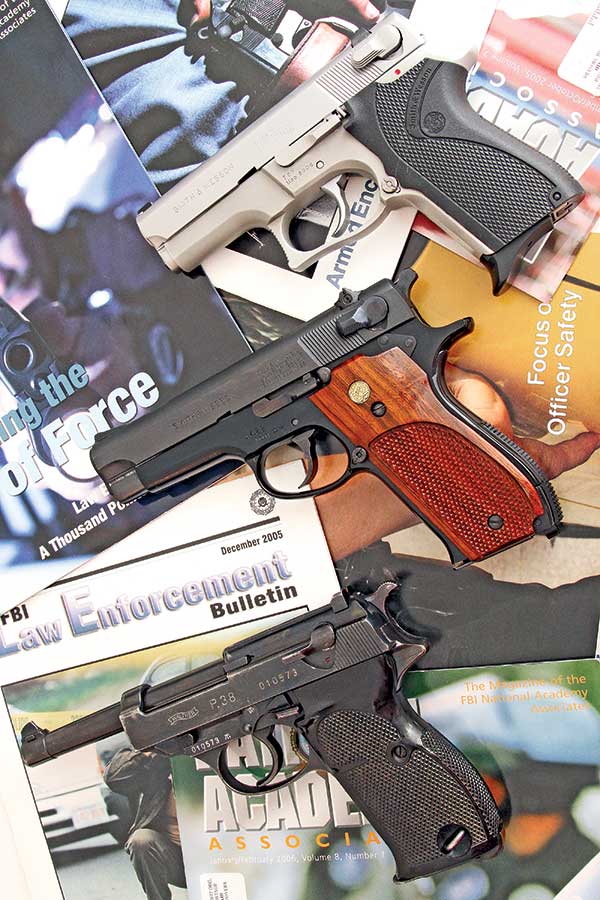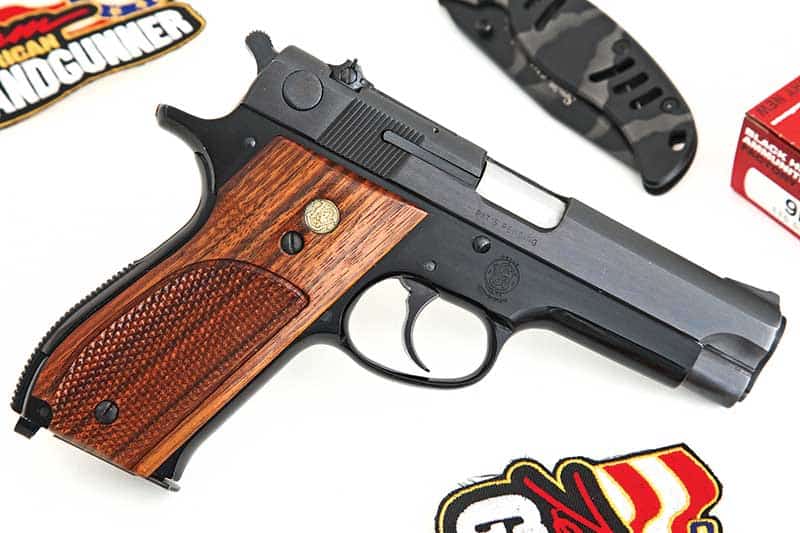Historically Important:
S&W's Model 39
In 1946 Carl H. Hellstrom was elected president of S&W. An enthusiastic and energetic man, Hellstrom immediately set S&W on a course toward improved production facilities and the development of new models. Favorably impressed with the Walther P38, he wanted S&W to have a double-action 9mm semi-auto.
S&W’s chief designer, Joe Norman, had a prototype, serial number X46, ready on October 28, 1948 — the first American-made, DA 9mm. Oversimplifying a bit, the design combines the receiver of a P38 with the slide/barrel assembly of a 1911. The receivers of the P38 and the S&W are so similar the magazines will interchange. Although P38 mags won’t lock in a S&W receiver because they lack the cut in the magazine body for the magazine catch.
Rather than the dropping block lockup of the P38, S&W stayed with the proven Browning-designed tilting barrel, controlled by a cam as on the Browning Hi-Power. The front of the barrel fits a bushing in the front of the slide, similar in concept to the 1911.
The prototype used an alloy frame. Wanting to cover all bases, in the early ’50’s the factory forged 1,000 steel frames. They also designed a single-action variation. Samples were provided to the US military for testing. About this time the military decided to stay with the pistols on hand. It would be another 30 years before a new pistol was adopted.
Cops Find It
In 1954, with no military contracts in sight, S&W decided to release the alloy-framed model for commercial sale. Uncertain about how the DA feature would be accepted, in 1954 to 1955 they made 10 DA and 10 SA production models.
There proved to be virtually no interest in the SA version, and in fact little enough in the DA model. No more SA’s were built, and only a total of 797 DA models were made to the end of 1956. In 1957 the DA version was assigned model number 39. Total production in 1957 was just 426 pistols.
The SA version was designated model 44. The model 44 remained in the catalog until August 1959 in the hope of getting some orders, which never happened. No additional SA’s were made, and none of the few produced were ever stamped with the model number 44.
Another “phantom” model number is the 39-1. The US Army Marksmanship Unit had developed a semi-rimmed version of the .38 Special they called the .38 AMU. At the request of the AMU, S&W made 87 alloy-framed pistols for the cartridge, intended to be named the 39-1.
When the frames were completed, to avoid confusion with the 9mm pistols, S&W decided instead to stamp the frames model “52.” When the AMU dropped the project S&W released the remaining pistols for commercial sale — but to avoid confusion with their steel-framed, .38 Special model 52, they restamped the alloy versions as model 52-A. Yep, no confusion there.
Remember those 1,000 steel frames forged in the early ’50’s? In 1966 the factory decided to finish machining the 927 steel frames still on hand, assemble completed pistols on them and release them for commercial sale. These were marked model “39” and sold along with the alloy framed version, in three s/n ranges: 35,000 between 60,000-64,000 and 80,000.
Growing Pains
As interest in centerfire semi-autos grew in the ’60’s, sales of the model 39 slowly picked up. The biggest boost came in 1967 when the Illinois State Police adopted it as their duty sidearm. More extensive use revealed some weaknesses. A shorter, spring-loaded extractor, heavier duty barrel bushing and a reshaped feedramp resulted in the model 39-2 introduced in 1971.
Several other police agencies also adopted the 39 and its high-capacity version, the model 59, released in 1971. As Massad Ayoob reported in the J/A 1978 issue of Handgunner, several of these agencies soon transitioned back to revolvers, usually stainless-steel .357’s. Problems reported were an unacceptably high rate of malfunctions, especially with bullets other than FMJ-roundnose and concerns with 9mm stopping power. There was still a lot to be learned about bullets and semi-autos.
S&W put the lessons learned to good use in developing its 2nd generation (3-digit model numbers) and 3rd generation (4-digit numbers) semi-autos. These proved successful, as police transitioned en masse to semi-autos during the 1980’s. Available in more models, variations and cartridges than I have space to list, they remain exceptionally fine pistols.
For collectors, the model 39 has many variations. Blue steel and nickel plating, 39’s and 39-2’s, alloy and steel frames, pre-model numbers, .30 Luger versions (500+ made for sale in Italy), and you can dream of someday coming across a SA model or a 52-A. And don’t overlook the 2nd generation models 439, 539 and 639.
Mine is a blued 39-2. It’s completely reliable with every JHP load I’ve tried. The grip frame is very comfortable, it’s adequately accurate, handles beautifully and is light and compact. To my eye it’s one of the handsomest pistols ever made, and a historically important model.





